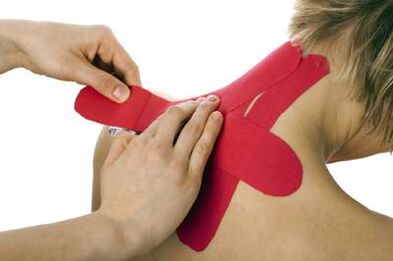A sitting lifestyle, which is characteristic of office workers and those who would like to relax in front of the television or behind the monitor screen, often cause osteochondrosis. In the article we will consider what osteochondrosis of the cervical spine is, the main causes of this disease, their symptoms and stages, treatment methods and other questions that arise in patients with osteochondrosis.

The osteochönig process influences one of the spine or several at the same time. The lumbar and cervical vertebrae are most affected by pathologies that are most susceptible to loads due to the anatomy of the human skeleton. The consequences of osteochondrosis in the spine in the cervix region cause the greatest inconvenience and potential complications because the neck is an area that is rich in neuromusive motorways, many of which directly feed the brain. In addition, the nerve roots that provide the sensitivity and motor activity of the hands and shoulder girdle, a variety of symptomatic image when pressing with destroyed vertebrates.
Signs of a neck osteochondrosis depend on which of the body systems are influenced by the pathology:
- Disturbed blood circulation due to the pressure of the vertebral arteries determined most symptom complexes from the brain.
- The compression of the roots that leave the vertebrate gives a picture of the lesion of the peripheral nerves.
- Inclosing spinal cord areas is associated with severe neurological pathologies that have been found in advanced cases.
Note the general clinic of the osteochondrosis of the cervical spine below. Pain in mind, neck and collar. This is the most common symptom. The localization of pain can be expanded, which affects the shoulders, the collarbone region, the chest and intensive head migraine. The type of pain depends on the localization of the lesion and the severity of the pathology. First of all, the pain can quickly be temporary and gradually become chronic and painful. In moments of deterioration, the pain will shoot with an increased tone of the neck muscles and a limited movement of the head. Pain with cervical osteochondrosis can often be localized behind the star. In this case, many patients occupy this symptom for angina pectorator.
Must, ringing, damned in the ears
These symptoms often follow to decrease in hearing. These phenomena are associated with a decrease in blood flow from the vertebral arteries to the vestibular apparatus. The complex of these symptoms is referred to as cochlea or snail syndrome, and it is anything but always possible to determine the connection with osteochondrosis in the cervix region. A specific feature for differentiation is that noise, traffic jams and ringing can be felt in the ears after a long stay in a position.
dizziness
Dizziness is also due to a violation of the blood flow against the organs of the inner ear, which ensures the body's balance. Nystagm often combines dizziness - arbitrary fluctuations in the eye pupils on the sides.
Lack of air
This sensation appears due to the irritation of the ends of the diaphragm. It is part of the nerve beam in the cervix and is involved in the regulation of breathing, its depth and frequency. The patients complain about the inability to breathe in full chest. In some cases, the symptom exacerbates severe shortness of breath and suffocation. For the same reason, breathing stops at night and snoring. The disadvantage of oxygen due to breathing problems is ultimately the cause of increased fatigue, a decrease in concentration and memory problem.
Trimming
It is accompanied by the air air. Also due to problems with blood circulation in some areas of the brain and inner ear. Nausea is sometimes observed with indomitable vomiting, which are provoked by movements of the head and body. The consequence of frequent nausea and vomiting is a decrease in appetite, weight loss and digestive failure.
Problems with seeing

"Fly" in the eyes, a decrease in visual acuity, fog in front of the eyes - these are all symptoms due to the ischemia of the brain area responsible for seeing. Patients with osteochondrosis are less likely to complain because the lack of blood supply is compensated for by the vertebral houses by blood flow from the carbon artery system. Glasses and therapeutic gymnastics for the eye muscles do not solve the problem, usually seeing improves after the treatment of osteochondrosis.
Green symptoms
It can often be the only sign that indicates the cervical osteochondrosis. They are expressed as sweat, dryness and feeling of a clud in the throat and difficulties when swallowing. The symptoms are connected to the compression of the nerve plexus, which is responsible for the innervation of the pharynx. It is necessary to distinguish such manifestations from a similar clinic for inflammation or neoplasms.
How to treat cervical osteochondrosis
The described state of the spine is a very serious pathology that leads to disabilities and due to deep disorders of brain circulation and death. For this reason, you should not. Osteochondrosis is treated in a hospital and at home, exclusively by a doctor. In the first stages, the treatment of cervical osteochondrosis is conservative, including drug recipes: non -steroidal anti -inflammatory medication, anesthetics, hormonal medication, vitamin complexes, chondroprotectors -all this allows inflammation, improve the trophic of mechanical and the norilage evertebrae.
During the acute time, medication in the form of injections is prescribed because the patient declines that the patient goes to tablets. Physiotherapy, massage, exercises that are normally prescribed in the remission stage, join the drugs. In difficult cases, osteochondrosis is treated with surgery.
The cervical icing diagram
Osteochondrosis of the cervical spine (osteohondroz) is a degenerative-dystrophic lesions of the intervertebral discs, which damage the wheels, vertebrae and joints of the cervix area, a decrease in the amount of the Grand Cell. The disease continues if it is not treated and can lead to headache, circulatory diseases and even hernias. Like osteoporosis, the disease occurs due to a violation of the mineral metabolism, according to which the bones and joints become less durable. Osteochondrosis can cause an instability of the cervical spine (symptoms and treatment are similar to chondrosis, but have a number of characteristics), which is often accompanied by a shift in the vertebrae. This in turn accelerates the development of osteochondrosis and destroys the vertebrate.
The main causes that can cause osteochondrosis:
- improper nutrition and overweight;
- Violations of attitude, scoliosis, rheumatism, flat feet;
- Settling lifestyle: sitting work (driver, office worker), lack of physical exertion, etc. ;
- Injuries in the neck, spine injuries;
- Too much physical activity, unusual for the body;
- Nervous tension, frequent loads;
- hereditary disposition for the development of the disease;
- Wrong development of the cervical spine.

Most of the above reasons cause a strain on the cervical vertebrae, with the muscle cramp occurring. For this reason, the blood circulation process is disturbed, the effectiveness of metabolic processes is reduced, which causes degenerative changes. The structure of the intervertebral discs changes, they are diluted and deformed and speak beyond the spine. The cause of osteochondrosis is often a progressive pane that spreads to neighboring vertebrae or bone tissue. It occurs most often with longer physical exertion in lumbar and cervix and almost never touches the chest. The development of osteochondrosis goes through several stages that are characterized by certain signs and symptoms. We will look at these phases below.
Osteochondrosis of the 1st degree of the cervix region (preclinical stage)
Usually only a slight smoothing of the neck lord can is observed in the early stages of the development of the disease. Patients have pain that mix with the curves and tilting the head, tension and a quick tiredness of the muscles in the back and lower back. At this stage, osteochondrosis is healed without medication, it is sufficient to change the diet, carry out exercises and other events.
Osteochondrosis 2 degrees
In the second phase between the vertebrae, instability is observed, the patient begins to disturb a more intensive pain that regularly gives it to his hands or shoulders, the pain is also reinforced with curves and heads of the head. The patients notice a quick fatigue, lack of lack, reduction in performance levels and headaches.
Osteochondrosis 3 degrees
The pain begins to reinforce at this stage, it occurs not only on the neck, but also in his shoulders, there are hands. The hand muscles become weaker, deafness is observed because hernia begins to form of intervertebral discs. In this case, the diagnosis shows the low mobility of the cervix region. The patients are concerned about dizziness and weakness.
Osteochondrosis 4 degrees
In the last stage, the intermediate disks are destroyed by connective tissue. The pathological process affects several segments of the comb at the same time, which can be in different stages of destruction. In patients, violation of coordination, dizziness and pain is reinforced, there is noise in the ears and other disorders. Even the initial stage of the disease can be identified according to the following signs:
- Headache for osteochondrosis of the cervix region
- Pain in the neck, neck, shoulders or arms;
- Hand weakness;
- Crunch and pain during the head movements;
- General weakness, fatigue, impairment of coordination, dizziness;
- Reduction of the sharpness of seeing and hearing, deafness of the language.

One of the most common signs is dizziness for osteochondrosis of the cervical spine. At the same time, the symptoms of dizziness from the noise and ringing in the ears (reduced hearing light), the sensations of disorientation, migraines as well as nausea and vomiting can be accompanied. In addition, it is the doctor who realizes how to treat these symptoms that you should not try to get rid of dizziness with folk methods. Another unpleasant consequence is common headaches, especially in women. Migraines can occur several times a day and cause unpleasant and painful sensations. Signs of the disease of the cervix region manifest themselves in a slightly different way than the osteochondrosis of the other spine, since the vertebrae in the throat are close together. The height of the intervertebral discs is low, which leads to complications even with minor degenerative changes.
Symptoms of cervical osteochondrosis that occur in the brain
With the development of osteochondrosis, the blood flow to the brain is reduced by arteries, which are compressed by the protruding edges of the vertebrae. As a result, there is a violation of the blood circulation of the brain. In patients, neurotic diseases are observed: irritability, fear, frequent change in mood, resentment, insomnia and focus ability. In some cases, outbreaks of anger, fear and longing can occur. Vascular cramps can lead to fainting, headache, noises in the ears and the appearance of points in front of the eyes. In this case, the following symptoms occur: dizziness, a feeling of instability, nausea, in some cases vomiting.
Treatment of osteochondrosis of the cervical spine
Various methods are used for the treatment of such disease such as osteochondrosis: medicines, physiotherapy, massage of the cervical brotherly zone for the blood supply to the brain and the therapeutic gymnastics and the maintenance of proper diet. Despite the fact that women are more susceptible to headache and deafness of the limbs in this disease, the treatment of cervical osteochondrosis in women does not differ from their treatment in men: the same medication and exercises are prescribed.
Diagnostic methods
An experienced doctor easily diagnoses cervical osteochondrosis because the disease has a characteristic clinical picture. In order to determine the phase, neglect and prevalence of the pathological process, a number of additional examinations are prescribed to the patient:
- Radiography - A change in mobility and arrangement of the vertebrae, a decrease in the band fire tears, saline deposits are determined;
- Computer tomography - it enables gaps, changes to the disc height, the instability of the vertebrae, the compression of the nerve fibers and the spinal cord.
- The magnetic resonance imaging ensures that you see pathological changes exactly, determine the blood flow and the condition of the nerve roots.
Usually only the radiography of the cervical spine is sufficient, more expensive methods are used in confusing and unclear cases.

Medical physical education
Exercises for osteochondrosis are strictly cervical during the remission, and movements in the acute phase can lead to a deterioration in the patient's condition. All physiotherapy exercises are reduced to the curves and tendencies of the head. It is important to carry out actions slowly without sudden movements. In the event of pain - stop the lesson and look for a specialist.
If a person has a tendency to develop pathology, she has to visit a specialist regularly and undergo. This will help to identify the disease at an early stage and to start the treatment in good time. For example, the cervical osteochondrosis, the symptoms of which are described in the article, influence the cervical vertebrae and begins to literally destroy them. What will become of it is easy to guess.




















